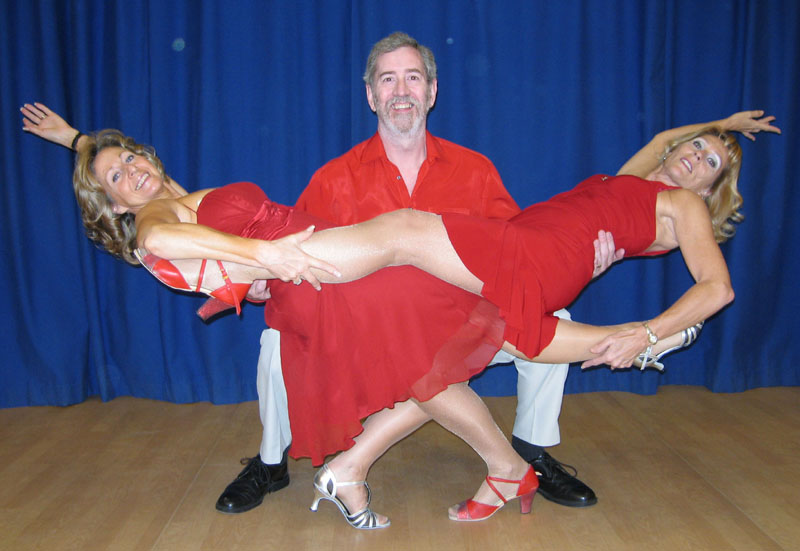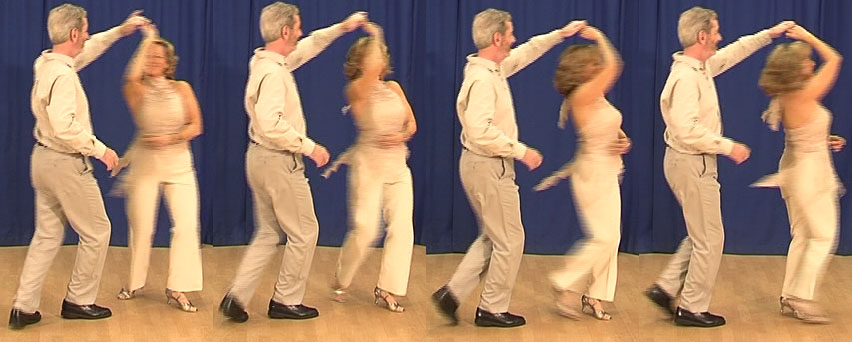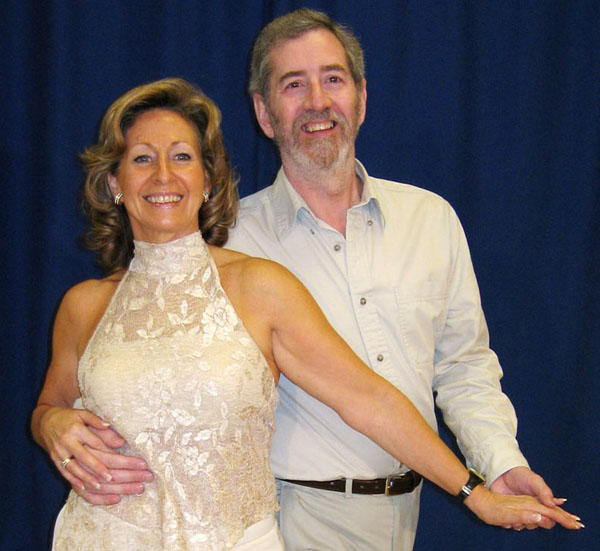Do you ever find that moves don't work out quite as smoothly as you hoped? Or that you lose your balance when turning or returning? Or that your arms or shoulders ache after a night's dancing?
It's all to do with tension! Let's look at some basic principles of Modern Jive:
I hope 1), 2) and 3) are self-evident. Let's look a little more closely at 4) and 5).
A frame involves a fixed relationship between the arms or bodies or the two dancers. Just examine a simple First Move step by step and you will see that the relationships change with each step that you take. There really is no frame in a First Move, nor in any of the basic Modern Jive moves. Now, Modern Jive is a very rich dance form, and borrows moves from many other dance styles, so, yes, there are some moves that people have taken from sources such as Latin or ballroom dancing that do use a frame. This is one of the challenges of Modern Jive, the need to adopt a frame briefly for one move and then discard it again as you start the next move.
You may also hear people talk about body leads. Whether it is used as a visual clue or to cause the lead to be transmitted through the arms, a body lead requires there, again, to be a fixed relationship between the two dancers' bodies. What is the first thing you do in most Modern Jive moves? Step away from each other, thus changing the relationship between your bodies! Basic Modern Jive moves do not use body leads.
Which all leads into the fifth principle: There is no frame, and little opportunity for body leads; and the only contact normally is your finger-tips. So: Lead & Follow is primarily through the finger-tips.

I will assume that we have a man leading, and a lady following.
The man needs to understand:
For basic Modern Jive moves, the lady doesn't need to know the moves at all. She needs to know how to follow. Sadly the vast majority of most lessons is devoted to teaching the men how to do the moves and little information is provided to the ladies, especially on the techniques of following.
When the man moves your finger-tips, what does he want you to do? He wants you to use your feet to follow the lead. If you resist then you will be late moving your feet, and you will prevent him leading the next part of the move. So follow his fingertips.
There are two parts to following:
If you achieve this you become a "light dancer" - someone with whom it is a pleasure to dance, someone who follows effortlessly. Being a light dancer is nothing to do with your weight - it is about being responsible for your own balance and following immediately so that you feel like a feather to the man who is leading you.
Now this is actually quite hard, so let's look at some ways to practise this with a partner.
The man offers his hand, the lady places her hand into it. That is a basic connection. Now you need some tension. Everyone will tell you that. But what they don't normally tell you is how much tension - one gram or 100 kilograms? The best answer I have found in discussing this with countless teachers and champions is that you should start with zero tension and only increase from there to the minimum that you need to make the move successful. Yes, Lady Spins and Push Spins need more tension, but only for a fraction of a second - then you need to relax again.
The connection between your hands is along the line between you and your partner. Don't pull your partner's hand up, down or sideways. Try getting the man to take his hand away, the lady's hand should stay where it is because she is holding it there, not weighing down on the man.
Try holding both hands and just stepping backwards and forwards - the connection should stay the same - close to zero tension. Don't tense up - you should be as relaxed as if you were walking down the street holding hands! You should be able to do it knuckle to knuckle without losing contact.
Standing still, get the man to offer both hands, but only take one of them. The man now raises both hands quite quickly - but smoothly and gently. The lady should raise her connected hand at the same speed so that the hands maintain that smooth connection. Lower them both the same way - again it is the lady's responsibility to follow so that the connection is maintained. Try it again and see whether it is harder for the man to raise and lower his connected hand than his free hand. If the lady is following well the man should find both hands feel exactly the same.
Now men, gently move your hands towards you. Ladies, keep that light connection without making him work. Now men, move that hand back towards the lady. Ladies, make it effortless for him.
OK - now it gets harder. Take both hands. The man can move either hand in any direction at any speed and the lady has to keep a light connection. Ladies, focus on keeping your fingertips touching his. Try a Hallelujah/Rainbow at different speeds, letting the man lead the speed.
This is not an easy exercise. But it is well worth perfecting as it is the key to successful Modern Jive. This is dynamic tension - flexible arms following without resistance.
When men talk about a lady being light or heavy there are two aspects - how much work it takes to get the lady to move across the floor, and how much work it takes to move the lady's arms. Both should be effortless. Sometimes it feels like you're trying to move her arm through treacle. Ladies, if you find yourself getting half a beat behind in some moves, this may be the reason - having heavy, stiff arms slows you down - try keeping your arms more flexible to give them a lighter feeling, this will make it easier to follow the man's lead more quickly. Try it and see how much more quickly you can react and move.
Once you have mastered these exercises, try some simple moves like the Octopus.
Gentlemen, if you are too rough, too strong, or drag the ladies around the dance floor, then they may need to tense up to protect themselves from injury; then you have to pull harder; then they get more tense; and we end up wrestling instead of dancing. Give a gentle, clear lead and give the ladies a chance to show you how well they can follow quickly with their feet.
Hopefully we have established by now that leading is all about the man moving the Lady's finger-tips. When you move someone's fingers you are leading. So ladies, it follows that if you use your muscles to control what the man's hand is doing then you are leading. Please don't!
It happens a lot during freestyle dancing. The lady recognises a move and starts executing it without waiting for the man's lead. Beginner men will never learn how to lead if you do this, and experienced men will get frustrated when they try interesting variations or speed changes and find the lady hijacking the move into something different. One of the main places it happens is during a turn or a return - the lady often brings the connected hands around or down at her choice of speed, whether the man wants it or not. It can be quite a wrench when the man isn't expecting it.
This is especially important in moves such as a Pretzel or a Half-Nelson Duck where the man is putting his arm behind his back - it takes very little effort on the lady's part to hurt him in these positions - unless you are looking for revenge, please take that little extra effort to relax those arm muscles, keep gentle connection with the finger-tips and wait to see which variation he is doing.
We all have lots of muscles and tendons in our shoulders. Every time either dancer uses too much muscle or applies quick or unexpected tension it affects those delicate parts, and if you dance a lot you get repetitive stress injuries. Watch your partner as they walk off the dance floor and check that they are not rubbing their shoulders!
If you are dancing with a rough partner (male or female) it can be very difficult to know how to get them to stop hurting you. And if someone does manage to get up enough courage to tell you that you are using too much muscle, please take it as a constructive and helpful comment, not as a personal insult. I have had ladies say to me very sharply, "Well no-one ever told me that before!", and I am thinking, "No, because they were scared you would react like this".
I often get ladies telling me that they can't relax, because:
Let's look at turns and returns. This is another area where too much tension causes problems. It throws you off balance and slows you down. The slowing down comes from the lady using her arm muscles to resist the lead. You will never do timely double turns or double-speed turns if you fight back. The principles above all apply: use your arm muscles to keep your fingertips touching his, and if he is giving you some help turning take it and use it, donít resist it and waste the energy.

The balance problem comes in two parts. In order to turn smoothly the lady needs to be balanced - body upright, feet close together and the connected finger-tips just above her head. Sometimes the words we use can be unhelpful. We often say, "The man turns the lady." It would be much more accurate to say, "The man leads the lady into a turn - the lady turns herself." Yes, the man can add a little help by making a very small circular motion with his fingers, but the best place for those fingers is directly over her head. If they are off-centre then the lady is thrown off balance.
The second part of the problem is the lady tensing her arm when she does a turn. This has two results: firstly it tends to straighten the arm, which tends to take it away from above her head, which throws her off balance. Secondly it locks the arm and the body together, so instead of the body being able to turn smoothly it is controlled by the arm. If either of the dancers is causing the connected hand to be off-centre, then the body is turning at an angle and you lose control.
A relaxed arm with the finger-tips above the head means that you can turn quickly and smoothly.
So men, practise giving a clear, gentle lead, and ladies, practise being a light follower and not anticipating the moves. Relax and have fun!
This article first appeared in Jive Magazine.
I hope you have found this article useful. If you don't agree with any of it please e-mail me at john@modernjive.com - if there is something I have misunderstood I would love to learn more.
If you have any questions please contact me and I will do my best to help. If you want more information about this subject or anything else to do with Modern Jive technique, please have a look at The Modern Jive Toolkit Video.
John Sweeney has been dancing all his life, specialising in Modern Jive for the last 25 years. He is a freelance Modern Jive teacher, teaching for all the major organisations all over the world. John learnt a lot about lead and follow while working on Double Trouble, having to lead two ladies at once, and winning all the major UK Double Trouble Championships. He has produced a number of videos covering Modern Jive technique, interesting moves and Double Trouble. You can find out more at modernjive.com.
This article is copyright John Sweeney 2011.
